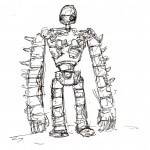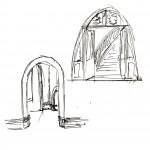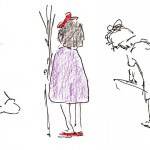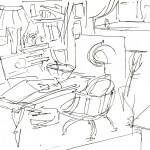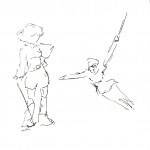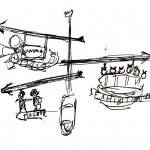Visiting The Ghibli Museum
The Ghibli Museum, Mitaka, Tokyo
Located half an hour’s train ride away from central Tokyo, the Ghibli Museum sits in a quiet park in Mitaka. Following Totoro-topped signposts, your first sight as you arrive is of a life-sized Totoro toy manning the ticket office at the forest-spirit-topped gates of the complex.
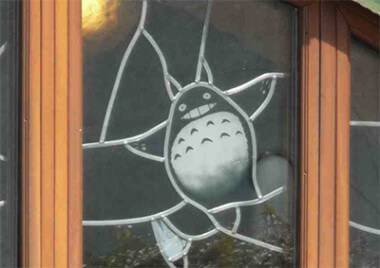 The building itself follows Miyazaki’s environmentally friendly ideals; it is absolutely covered in greenery to the point that it almost looks like it has grown out of the ground itself! As you walk around the side of the building to the actual entrance, you see windows and doors into the museum. Looking closely you find that characters and scenes from the films are immortalised in stained glass there.
The building itself follows Miyazaki’s environmentally friendly ideals; it is absolutely covered in greenery to the point that it almost looks like it has grown out of the ground itself! As you walk around the side of the building to the actual entrance, you see windows and doors into the museum. Looking closely you find that characters and scenes from the films are immortalised in stained glass there.
Surprisingly for such a famous museum, there is almost no queue to get in; there are only a certain number of tickets sold for each day. If you are planning a visit be aware that tickets tend to sell out around a month in advance so book early to avoid disappointment!
The only sad thing as you walk into the museum is that you’re not allowed to take photos; everything else is wonderful! The best way I can describe the interior of the museum is that it’s like a hobbit hole; between the warm wood used for the floor, walls and stairs, the rounded doors and windows, and the light shining in through a skylight in the central hall, the place feels intimate and relaxed. The stained glass windows and the flower-like stained-glass wall lamps add a sense of colour and magic akin to The Secret World of Arrietty, while the excited murmur of conversation and shuffle of footsteps of fellow visitors increases your sense of wonder.
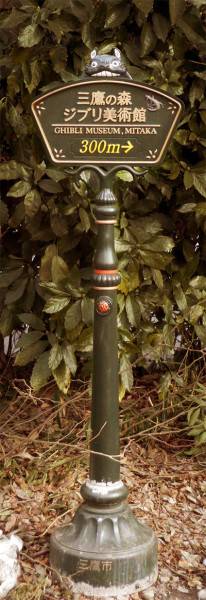 The central hall is three-floors high, with galleries looking down from the upper two floors and bridge-ways between the balconies. A graceful wooden staircase leads you upwards but there is also the option of a glass lift. Delicate iron colonnades support the balconies, matching the banister of the staircase and the railing of the galleries. On the walls are painted portals into the worlds of the films; painted in perspective, complete with steps and handrails, it seems like you can just walk into them.
The central hall is three-floors high, with galleries looking down from the upper two floors and bridge-ways between the balconies. A graceful wooden staircase leads you upwards but there is also the option of a glass lift. Delicate iron colonnades support the balconies, matching the banister of the staircase and the railing of the galleries. On the walls are painted portals into the worlds of the films; painted in perspective, complete with steps and handrails, it seems like you can just walk into them.
A weather-vane-style signpost hangs from the gallery bridge, pointing towards various rooms. Doorways lead away; adult-sized, child-sized and soot-sprite-sized.
The first room is the Exhibition Room. The lights are dimmed and Ghibli piano music plays gently in the background. The room functions as both a celebration of the Ghibli films and of the medium of animation. Open-sided projectors throw films onto the walls, their cogs whirring. Other projectors need you to turn their handles yourselves. Glass cases hold models of scenes from the films, tall boxes display multi-plane scenes, zoopraxiscopes spin and dollhouses hold figurines to admire. The place has an atmosphere more akin to a toyshop than a museum!
Just off-centre of the room is a zoetrope inside a glass column that stretches from floor to ceiling. Inside, a Laputan robot with his eyes and arms raised slowly rotates as animated birds fly in a whirlwind around him. Combined with the lighting and the background music, it is very emotional. The centrepiece of the room however is a carousel; the middle column is Totoro’s tree and around the tree are frame-by-frame models of the characters from ‘My Neighbour Totoro’. When the carousel spins, everything is an incomprehensible blur until the display’s lights are turned off and strobe lighting is turned on. Suddenly what was a blur becomes the bat flying, Catbus leaping, Totoro jumping, the girls playing skipping rope and rabbit spirits running around the other characters.
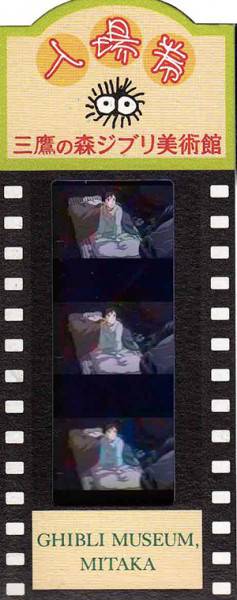 The next attraction is the Cinema. At the entrance to the museum you are provided with a ticket made from part of a Ghibli filmstrip, three frames per person, which allows you to enter one showing of the film. Exclusively shown at the museum, the film is a fifteen-minute short about an old couple who live on a hill and who train up their house mice to win at a sumo wrestling competition against the forest mice. The film has a lovely charm but the best part was seeing the reactions of the children in the screening room; they were having the time of their lives!
The next attraction is the Cinema. At the entrance to the museum you are provided with a ticket made from part of a Ghibli filmstrip, three frames per person, which allows you to enter one showing of the film. Exclusively shown at the museum, the film is a fifteen-minute short about an old couple who live on a hill and who train up their house mice to win at a sumo wrestling competition against the forest mice. The film has a lovely charm but the best part was seeing the reactions of the children in the screening room; they were having the time of their lives!
Upstairs is a replica of Miyazaki’s workroom, complete with desk, chair, mugs full of pencils, jars full of brushes and inspirations haphazardly scattered around. Model planes hang from the ceiling, a globe sits on a stand in the corner and shelves are packed with books. The room looks as though it has just been vacated; watercolours still out and half-finished paintings on the desk; the whole room is in wonderful, organised chaos.
For visitors, the walls have been covered, and I mean covered, with original sketches, watercolour paintings, storyboards, character designs, background designs and inspirations. Concepts from all of the films are on display and seeing them in real life, as with any artwork that you admire, is absolutely magical, even though I had seen some of the drawings in art books previously.
- Sketch ©2014 Julia Young
- Sketch ©2014 Julia Young
- Sketch ©2014 Julia Young
- Sketch ©2014 Julia Young
- Sketch ©2014 Julia Young
- Sketch ©2014 Julia Young
If we take the first room as a replica of Miyazaki’s pre-production process, then the next room is storyboards and the room after is production. In the second room, books of all of the storyboards of all of the films are out for visitors to look through and enjoy. The third room is a replica of Miyazaki’s animation room and desk, complete with more animator-mess and cigarette butts in the ashtray. Where the pre-production room was covered in concepts, this room is covered in final model sheets, rough and final pencil frames and final coloured cells. As you leave the room, overwhelmed and vaguely dazed, you pass more child-height projectors with children enthusiastically winding them and characters painted onto the wall waving you goodbye.
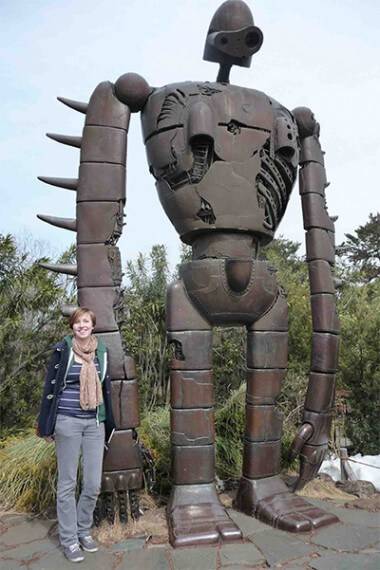 Across the balcony, on the other side of the central hallway, is a life-sized Catbus toy, primary school children happily climbing on it, sitting in it and generally having a brilliant time. Behind that is a door onto an outside balcony from which you can climb a spiral staircase onto the roof garden to say ‘hello’ to the enormous Laputan robot guardian of the museum. Beautifully detailed in its garden, you are once again transported into the film world.
Across the balcony, on the other side of the central hallway, is a life-sized Catbus toy, primary school children happily climbing on it, sitting in it and generally having a brilliant time. Behind that is a door onto an outside balcony from which you can climb a spiral staircase onto the roof garden to say ‘hello’ to the enormous Laputan robot guardian of the museum. Beautifully detailed in its garden, you are once again transported into the film world.
Returning indoors, you can enjoy a room full of books, both recommended by Miyazaki (such as The Illusion of Life by Frank Thomas and Ollie Johnston alongside children’s books) and published by Ghibli (both art books and books of the films’ storyboards).
The café and shop are last places to visit and certainly you need to sit down for a while to take in everything you’ve just seen!
To finish, if you are in the Tokyo area at any point, it is more than worth the time to go and visit the Ghibli Museum! Enjoy!
For more information on the Ghibli Museum and to reserve tickets visit the official website


